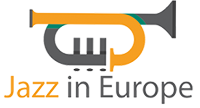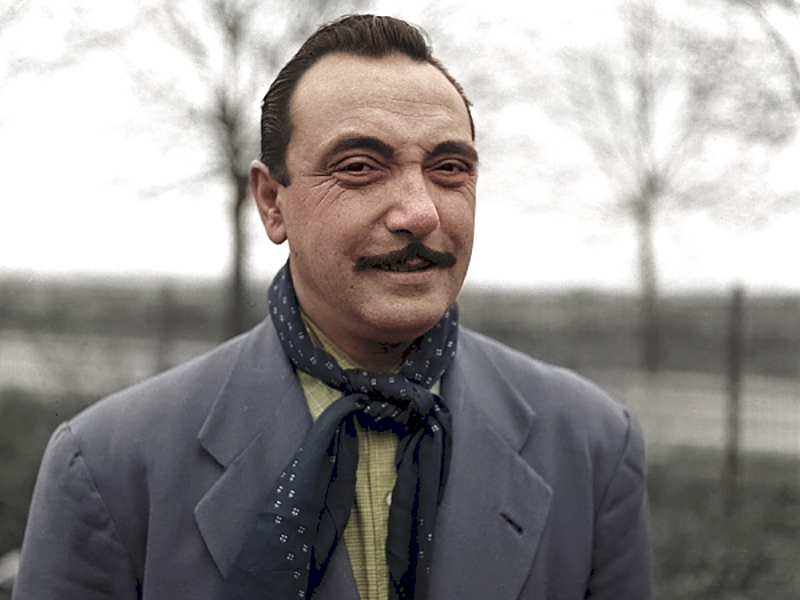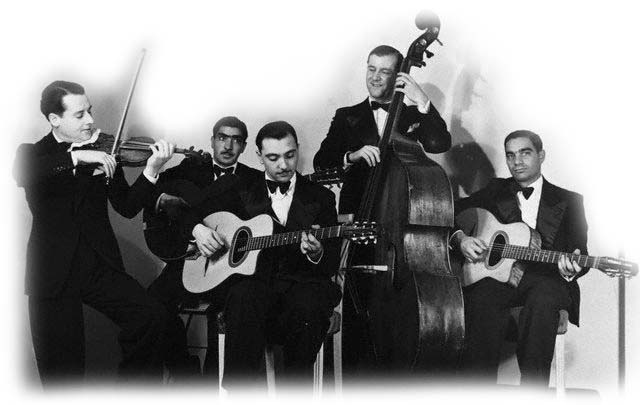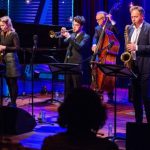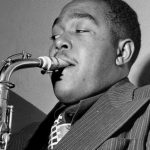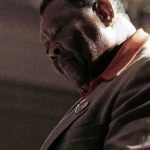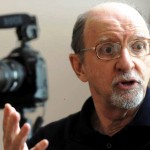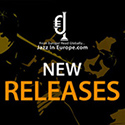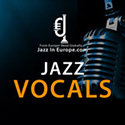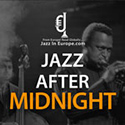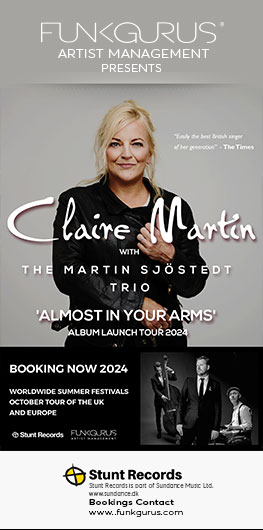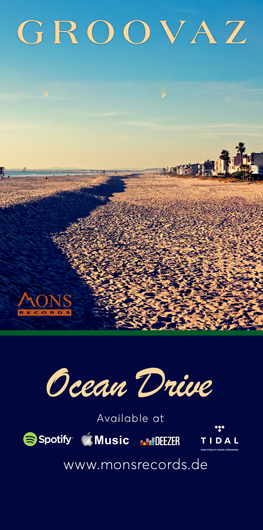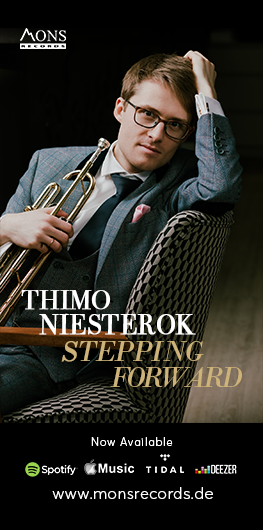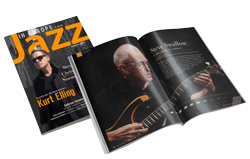Editors Note: Once again Lynn René Bayley from the Art Music Lounge has provided us with a gem. Her in depth article on Django Reinhardt explores many area’s not often touched on when looking at this icon of European Jazz. Enjoy.
Jean “Django” Reinhardt, born in Liberchies, Belgium on January 23, 1910, became such a legend even during his lifetime that his public admirers always wanted to know his latest moves, even when the man himself wanted solitude. Like so many extremely talented child prodigies, Reinhardt was spoiled to the point where he came to believe that the world revolved around him, thus when he became an adult and developed musical skills far beyond those of most mortal men of his time, he expected worldwide fame and fortune to befall him without any effort on his part. When he became disillusioned of this, it hurt his feelings so much that all he wanted to do was crawl into a hole and hide from the world. His long-time musical partner, violinist Stéphane Grappelli, called him “a petulant child,” but it went much deeper than that, and to a certain extent I understand why he felt so hurt.
The story of Django—whose name, by the way, has two completely different pronunciations, “Jango Rine-heart” in English and “Zhangoo Reynard” in French—is so well known as to be redundant in its telling. He was, as I say, a child prodigy who by age 10 was playing the violin, banjo and guitar at a high technical level, but who was totally immersed in French musette music and gypsy culture; at age 18, already married, he accidentally knocked over a candle in his caravan trailer, which set fire to celluloid flowers his wife had made, and was so severely burned that the doctors wanted to amputate his left hand, but Django refused despite the fact that his ring finger and pinky on that hand were permanently welded together in a useless lump of flesh; and how he managed to devise an entirely new technique of guitar playing using only the first two fingers of his left hand to produce dazzling fast runs up and down the fingerboard, playing with such speed and accuracy that it left all other guitarists in the dust. All of this is true, and as a sidelight I find it interesting to point out that the two most unique and influential jazz musicians of the 1930s and ‘40s, Reinhardt and Art Tatum, both used a two-finger technique to play their instruments in a way that able-bodied guitarists and pianists could not.
We also know that it was while he was recovering from his injuries, which took a full year, that his friend Émile Savitry tried to cheer him up by playing him jazz recordings from his collection. The ones that impressed young Reinhardt the most were those by Louis Armstrong, who he always cited as his idol, and the duo recordings of violinist Joe Venuti and his childhood friend, guitarist Eddie Lang. In Django’s mind, the image of a jazz band employing violin, guitars and string bass emerged, but it would be a few years before he was able to bring this idea to fruition.
Since I’m not really trying to write a detailed biography of Reinhardt, I would rather skip over the details of the founding of the Quintet of the Hot Club of France and their tremendous impact on European jazz and instead focus on what Reinhardt actually played on his guitar and why it was so revolutionary. Sheer speed, though impressive, would not have been enough to make him a legend. The guitar world is full of such “dazzlers,” from Snoozer Quinn in the 1920s to John McLaughlin in the 1970s and ‘80s. It’s what you play on the guitar that makes you great, not how fast you play it, and in this respect Django had a great deal to offer. Despite the fact that he was largely self-taught and could neither read nor write music, Django’s ear was so acute that he could absorb music like a sponge, and what he absorbed from Armstrong, Venuti and Lang, and all the other jazz musicians he would subsequently hear, was a full grasp of harmonics and how to use them. When one listens to the Hot Club Quintet recordings, even the early ones, one occasionally hears a familiar song being played with a few “wrong” chords according to the sheet music. But Django wasn’t reading the sheet music, and yes, he did know how the tune was played by others. As Grappelli put it, “He would adapt a song according to his lights.” Sometimes Reinhardt’s altered chords simplified the progression, sometimes it made it more chromatic, but in his mind it was done in order for him to be able to “fly” over the changes once he got to his solo.
Listening to those solos, one heard an audacious harmonic sense. Reinhardt was the first jazz musician after Earl Hines and Art Tatum to play extended chords, at least up as far as the 9th of a chord, as well as diminished and augmented chords. Some of this he picked up from other musicians, but much of it came from his own mind. This is what baffled and thrilled early audiences who heard him, on or off records, and this is what led many American critics—either out of spite or jealousy, I’m not sure which—to proclaim that Reinhardt was a “classical” guitarist and not a “real” jazz artist. They heard the exceptionally clean finger manipulation, and the way he did his picking very close to the sound hole, and ascribed this technique to classical training, which was far from the truth. Moreover, when I say “picking” I do not mean with a plastic pick. Django never used such a thing in his acoustic guitar days. All of the photos and film clips of him reveal him, and his cohorts (his brother Joseph and cousin Eugene Vees on rhythm guitars), “picking” the guitar with his fingernails. Django was also the first jazz guitarist to develop the “scrub,” which was to move the hand further up towards the top of the sound hole and literally scrub the strings with his calloused fingers. None of these techniques were used by American guitarists, then or later, for the most part.
Three American guitarists who Reinhardt clearly influenced were Junior Barnard, Charlie Christian and Oscar Moore. Moore’s name is only known to aficionados of the first Nat King Cole Trio, where despite his outstanding solos he took a back seat to the leader, and Barnard is barely known at all because he was a “country swing” guitarist with Bob Wills and his Texas Playboys, but both contributed much to the evolving use of the guitar, particularly Barnard when he switched to electric guitar and began playing wild, bluesy, out-of-phase solos that were to heavily influence the new “rockabilly” and R&B guitarists of the 1950s. But Christian became a legend in his own right, mostly by dying young of tuberculosis, and he is rightly recognized as the pioneer of the electric guitar in jazz. Christian was never quite as fast on the fingerboard as Moore, and certainly not as fast as Reinhardt, but his playing had a wonderful sense of construction and something Reinhardt never possessed, a feeling for the blues. (Incidentally, I’ve always found it fascinating that Christian and Barnard were childhood friends in Oklahoma and often played together as kids.)
But to return to Reinhardt, he and some of his cohorts played and recorded with some outstanding American jazz talent in pre-War France. These included such talented expatriates as trumpeter-saxist Frank “Big Boy” Goudie and fellow trumpeter Arthur Briggs, and even more famous visiting stars as saxists Benny Carter and Coleman Hawkins. In 1938, while the Duke Ellington band was touring France, a clutch of his best hot musicians made some excellent recordings with Reinhardt on guitar. Duke would not forget his harmonically sophisticated and rhythmically buoyant performances.
The Hot Club Quintet with Grappelli on violin came to a halt in 1940 when the Nazis invaded France. Grappelli was in England at the time, and decided to just play it safe and stay there for the duration of the war. Django formed a new Hot Club Quintet, this time with a clarinetist, Hubert Rostaing, and a drummer—Pierre Fouad, nephew of the King of Egypt! As both a jazz musician and a gypsy, Reinhardt’s life would clearly have been in jeopardy had not the Nazi officer assigned to that sector of Paris not been a jazz fan! He secretly protected Reinhardt as long as he could, and when he could do so no longer the guitarist disappeared. Not knowing where he was, rumors of his death made it to the newspapers until it was discovered that he had fled to Casablanca and was quite happy and secure there. Interestingly, he made it back to Paris in early 1944, before D-Day, where he participated in a recording session with some of the best jazz musicians from Glenn Miller’s Army Air Force Band: trumpeter Bernie Privin, clarinetist and tenor saxist Peanuts Hucko, pianist Mel Powell and drummer Ray McKinley. He also played on broadcasts, and made records with, Lonnie Wilfong’s Army Air Transport Command Band, a scrappy but hot aggregation that played the blues and meant it. Wilfong didn’t so much find Reinhardt as vice-versa; the guitarist just showed up one day while they were rehearsing and asked if he could sit in. They ended up playing a jam session into the wee hours which messed up their reveille the next morning, but they didn’t care. They were in musical heaven.
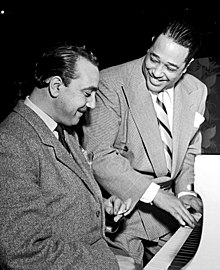 Always keeping his ears open, Django picked up some of the new, boppish-tinged tunes that the Air Transport Command band was playing, but was still playing acoustic guitar. In 1946 he finally came to America, accepting an invitation from Duke Ellington to play with his band. In his mind, Django envisioned that he would become a Hollywood star like his idol Armstrong, not realizing that this was the product of clever management by Louis’ representative, Joe Glaser. He never realized that Armstrong was a movie star because of his effervescent personality, and that the trumpet playing was merely an adjunct to that. Since his own proclivity offstage was to disappear and play cards, shoot pool and drink with his gypsy buddies, he wasn’t exactly the clean-cut image Hollywood wanted to project. And that’s exactly what he did when the Ellington band hit the stage in Chicago and Django was nowhere in sight. He hadn’t even bothered to bring his treasured instrument with him because he believed that American guitar manufacturers would be falling all over themselves offering him first-class instruments for free. It didn’t happen; Ellington had to send someone out to scour the bars in Chicago to find Reinhardt shooting pool with some gypsies, drag him to the stage and hand him an electric guitar to play, which he had never touched in his life.
Always keeping his ears open, Django picked up some of the new, boppish-tinged tunes that the Air Transport Command band was playing, but was still playing acoustic guitar. In 1946 he finally came to America, accepting an invitation from Duke Ellington to play with his band. In his mind, Django envisioned that he would become a Hollywood star like his idol Armstrong, not realizing that this was the product of clever management by Louis’ representative, Joe Glaser. He never realized that Armstrong was a movie star because of his effervescent personality, and that the trumpet playing was merely an adjunct to that. Since his own proclivity offstage was to disappear and play cards, shoot pool and drink with his gypsy buddies, he wasn’t exactly the clean-cut image Hollywood wanted to project. And that’s exactly what he did when the Ellington band hit the stage in Chicago and Django was nowhere in sight. He hadn’t even bothered to bring his treasured instrument with him because he believed that American guitar manufacturers would be falling all over themselves offering him first-class instruments for free. It didn’t happen; Ellington had to send someone out to scour the bars in Chicago to find Reinhardt shooting pool with some gypsies, drag him to the stage and hand him an electric guitar to play, which he had never touched in his life.
Although the American trip ended up a semi-disaster, Reinhardt fell in love with the electric guitar and went back to France determined to play it from then on. Also during his U.S. sojourn, he managed to hear some of the bebop being played by Dizzy Gillespie and Charlie Parker, and this too became part of his musical lexicon. Critics have decried Reinhardt’s early electric guitar recordings because, rather than play with a light touch knowing the amplifier would ramp up the volume for you, he continued to attack the strings as he did on his acoustic instrument, playing his fast-paced solos with hard finger strokes and using scrubs with his right hand, but I find these recordings extremely exciting despite the occasional distortion.
And this is where the majority of jazz fans leave off the Django Reinhardt story. They are so much in love with his pre-War acoustic playing with the Hot Club Quintet that they ignore the hundred or so magnificent performances he left us on electric guitar. (Some jazz buffs and jazz musicians, in fact, don’t even know that Django played electric guitar.) His harmonic language even more sophisticated, his drive and energy undimmed, he eventually moved into the modern jazz circles of Paris, playing with musicians who were in the vanguard of the new music like trumpeter Roger Guerin, pianist Martial Solal, vibes player “Fats” Sadi Lallemand, bassist Pierre Michelot and drummer Pierre Lemarchand. In fact, many of his later remakes of his old tunes, such as Nuages and Belleville, are markedly superior to the ones he made with either Grappelli or Rostaing. But he was no longer entirely unique; he was a great modern jazz musician playing in the company of other great modern musicians. His name still drew crowds, but not like before, and he wasn’t happy about it. He retreated to a cottage in the country where he spent much of his time painting or fly fishing. At the time of his premature death on May 16, 1953, at age 43, he hadn’t played publicly in two months, yet his funeral filled the streets of Paris with thousands of mourners. They may not have been happy about his more recent style, but they hadn’t forgotten how great or unique he was.
Ironically, his popularity had slipped among American musicians as well, largely because they were jealous that he kept up with the latest trends and could still outplay them. As Grappelli put it, “There were not a few guitarists in the world who were glad he was dead.” Then, in the early 1970s, Paul Simon recruited Grappelli to play a Django-like violin-guitar duet with him on his recording of Hobo’s Blues, and suddenly the Hot Club Quintet sound became popular again. Woody Allen mentioned him in Stardust Memories; several TV ads suddenly had a guitar and acoustic guitar swinging music in the background; and, in the early 1980s, American guitarist Frank Vignola finally unlock3ed the secret of Django’s style and formed the New Hot Club Quintet. Thirty years after his death, Django Reinhardt was finally hip and in style.
Yet there is still so much to hear in his recordings, particularly his many jazz recordings, that extended exposure to Reinhardt is still a “wow” experience. Playing such as his never goes out of date, only the perceptions of others who wish to simplify what he did and accomplished and ignore the astonishing creativity and sophistication of his music.
© 2017 Lynn René Bayley
Last modified: July 15, 2018

